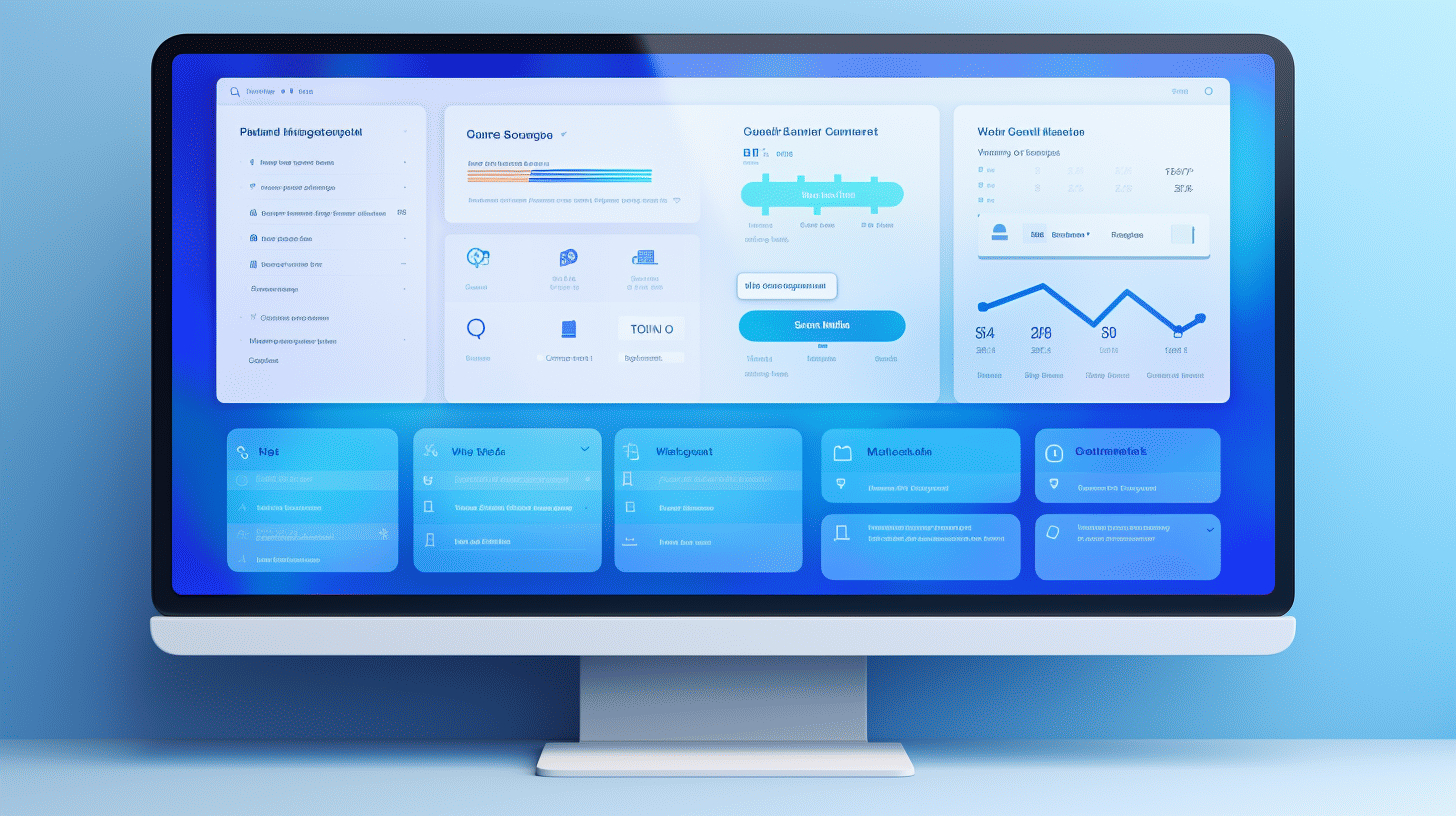由於其用戶友好的介面和強大的功能,WordPress 已經成為網站創建和管理的首選平台。隨著 WordPress 的流行度不斷增長,企業和個人面臨著有效管理其 WordPress 網站以確保最佳效能和安全性的挑戰。
為了應對這項挑戰,自動化已成為簡化 WordPress 管理的強大工具。透過自動化各種任務和流程,網站所有者可以節省時間、提高效率並專注於其線上業務的更具策略性的方面。
在本文中,我們將探討 WordPress 管理中自動化的強大功能以及它如何使網站所有者受益。我們將深入探討 WordPress 受歡迎的原因、它面臨的潛在威脅以及可以實施的安全措施。此外,我們將深入研究 WordPress 網站上的活動,並探索一些可用的頂級自動化工具和外掛程式。
因此,無論您是小型企業主、部落客還是管理多個 WordPress 網站的機構,都請準備好探索自動化如何徹底改變您的 WordPress 管理體驗。讓我們開始吧! 🚀
了解 WordPress 的流行程度
WordPress 已成為全球領先的內容管理系統 (CMS),其受歡迎程度逐年成長。在本節中,我們將深入探討 WordPress 廣泛使用的原因,並探討其市場份額、頂級網站上的使用情況以及使用這個強大的平台創建新網站的速度。
市場占有率
WordPress 在 CMS 市場中的主導地位是不可否認的。截至目前,它為全球所有網站提供了令人印象深刻的 63.3% 支持,鞏固了其作為個人、企業和組織首選 CMS 的地位[1]。憑藉其用戶友好的介面、廣泛的自訂選項以及蓬勃發展的開發者社區,WordPress 已成功佔領市場的最大份額。
熱門網站上的使用情況
但是,WordPress 在知名網站上的使用情況如何呢?嗯,統計數據表明,即使是最大的和最著名的網站也承認 WordPress 帶來的價值。在網路上排名前一百萬的網站中,有 36% 選擇了 WordPress 作為其首選 CMS[1]。這不僅凸顯了該平台的可靠性和可擴展性,也顯示了各行業主要參與者對 WordPress 的信任程度。
每日網站創建
每天都有數百個新網站上線,而 WordPress 正是這快速擴張的領導者。每天有超過 500 個網站使用 WordPress 創建[1]。這一令人印象深刻的數字表明該平台的易用性和可訪問性,使其成為希望建立強大在線形象的個人和企業的理想選擇。無論是個人部落格、電子商務網站還是公司網站,WordPress 都能提供將想法變為現實所需的靈活性和功能。
總而言之,WordPress 的流行可以歸因於其主導的市場份額、在頂級網站上的使用以及使用該平台創建的新網站數量的不斷增長。憑藉其強大的功能和用戶友好的介面,WordPress 仍然是全球數百萬網站所有者的首選 CMS。
「WordPress 為所有網站提供了 45.8% 的支持,在 CMS 市場中佔有 63.3% 的市場份額。
前 100 萬的網站中有 36% 使用 WordPress。
每天有 500 多個網站使用 WordPress 創建。[1]
[1] 附加資訊來源
WordPress 攻擊威脅及安全措施
WordPress 無疑是最受歡迎的內容管理系統 (CMS) 之一,全球數百萬個網站都在使用它。然而,它的流行是有代價的:這也使它成為駭客和自動攻擊的誘人目標。在本文中,我們將探討自動攻擊的普遍性,收集管理員對自動更新的見解,並檢查目前的軟體更新狀態。
自動攻擊的盛行
🔒 安全是任何網站所有者的首要任務,了解自動攻擊的普遍性可以幫助我們領先潛在威脅一步。以下是一些令人震驚的統計數據:
- 📊 97% 的 WordPress 攻擊都是自動化的。 網路犯罪分子利用自動化工具和機器人掃描網站漏洞、利用過時的外掛程式或主題並獲取未經授權的存取。
- 🚫 這些攻擊不是針對個人或有針對性的。相反,他們專注於尋找任何易受攻擊的 WordPress 安裝,而不管網站的規模或行業如何。
❓ 那麼,為什麼駭客主要依賴自動攻擊?主要原因有:
- ⏱️ 效率: 自動化攻擊可以同時針對數千個網站,最大限度地增加攻擊者找到漏洞的機會。
- 🔓 低風險: 駭客無需花時間進行需要專業知識和對目標更深入了解的手動攻擊,而是可以利用自動化工具廣泛撒網並希望成功。
- 💰 獲利能力: 自動化攻擊可能導致各種惡意活動,例如破壞、資料竊取或將受感染的網站變成向毫無戒心的使用者分發惡意軟體的平台。
管理員對自動更新的看法
現在我們了解了自動攻擊的普遍性,讓我們來探討一下 WordPress 管理員對自動更新的看法——自動更新是 WordPress 提供的一項自動更新核心軟體、主題和外掛程式的功能。
🧑💼 為了深入了解這個主題,我們進行了一項調查,以下是一些有趣的發現:
- 👥 52% 的 WordPress 管理員和網站所有者青睞自動更新,欣賞它帶來的便利性和額外的安全性。他們相信開發人員在發布更新之前會進行徹底的測試。
- 🙅 另一方面,48% 的管理員對自動更新表示擔憂。他們主要擔心的是主題或外掛可能存在的相容性問題、自訂修改可能被破壞、或網站行為可能出現意外變更。
- ⚖️ 儘管意見分歧,但調查結果表明,WordPress 管理員對自動更新的接受度越來越高,大多數人重視其安全優勢。
軟體更新狀態
為了確保您的 WordPress 網站的安全,及時更新軟體至關重要。然而,事實卻截然不同。
📣考慮以下與 WordPress 網站的軟體更新狀態相關的統計資料:
- ✅ 僅有 38% 的 WordPress 網站正在運行該軟體的最新版本。這意味著相當大比例的網站可能容易受到最新更新中修補的已知安全問題的攻擊。
- ❌ 其餘 62% 個網站要么運行的是過時版本,要么根本沒有實施任何更新。這使得他們面臨更高的自動攻擊風險,並使他們面臨已知的漏洞。
🔐請記住,保持您的 WordPress 安裝及其所有組件為最新對於維護您網站的安全性和完整性至關重要。定期檢查更新並及時採取行動,保護自己免受潛在漏洞的侵害。
總之,自動攻擊的盛行和管理員對自動更新的日益接受凸顯了網站安全性和便利性之間的持續鬥爭。透過了解這些威脅並採取主動的安全措施(例如及時實施更新),網站所有者可以大幅降低成為自動攻擊受害者的風險。保持警惕,保持更新,並確保您的 WordPress 網站安全。
WordPress 網站上的活動
您是否想過 WordPress 網站到底有多活躍?這個流行的平台上有數以百萬計的網站在運行,每天都有大量的內容創作和用戶參與。讓我們深入了解 WordPress 網站上令人著迷的活動世界,並探索這一切背後的數字。
內容發佈
WordPress 以其用戶友好的內容管理系統而聞名,該系統使網站所有者可以輕鬆創建和發布新內容。事實上,每月發布的 WordPress 貼文超過 7000 萬篇!與世界分享的文章、部落格貼文和其他形式的內容數量非常驚人。
無論是個人部落格、商業網站還是線上雜誌,WordPress 都為個人和組織提供了一個分享想法、創意和專業知識的平台。輕鬆發佈內容的能力促進了該平台的廣泛流行和持續成長。
用戶參與度
內容創作只是難題的一個面向;用戶參與度同樣重要。評論和與內容互動為 WordPress 網站增添了全新的活力和社群感。在這裡,訪客可以分享想法、提出問題,並與網站所有者和其他用戶互動。
您是否知道 WordPress 網站每月會收到約 7700 萬條新評論? WordPress 貼文留言部分發生的對話數量令人震驚。這種參與程度證明了 WordPress 生態系統中存在著活躍且充滿活力的社群。
全球網站流量
WordPress 的影響力遍佈全球,其網站橫跨各個產業和領域。擁有如此龐大的網站網絡,WordPress 每月吸引大量訪客也就不足為奇了。事實上,每月有超過 4 億人造訪 WordPress 網站!
如此驚人的網站訪問量展示了 WordPress 在互聯網上的實力和影響力。從個人部落格到電子商務商店再到新聞網站,WordPress 網站迎合了多樣化的受眾並提供豐富的資訊和服務。
因此,下次您瀏覽 WordPress 網站時,請花點時間欣賞幕後發生的大量活動。在這個世界裡,內容不斷被創造,使用者互相交流,數以百萬計的人瀏覽各種網站,而這一切都由多功能 WordPress 平台提供支援。讓我們擁抱 WordPress 網站的動態特性,並繼續為這個蓬勃發展的生態系統做出貢獻。
WordPress 自動化工具和插件
管理 WordPress 網站可能是一項耗時的任務,從更新外掛程式到安排內容。但是,借助自動化工具和插件,您可以簡化和優化 WordPress 維護流程。在本文中,我們將探討一些可以幫助簡化您的網站管理任務的頂級自動化工具和外掛程式。
怪物洞察
WordPress 最受歡迎的自動化工具之一是 MonsterInsights。超過 300 萬個網站都在使用此插件,它是 WordPress 領先的 Google Analytics 插件。透過 MonsterInsights,您可以輕鬆地將 Google Analytics 整合到您的網站,從而追蹤基本指標並獲得有關受眾的寶貴見解。從監控頁面瀏覽量到追蹤使用者行為,MonsterInsights 為您提供做出明智決策和不斷提高網站效能所需的資料。
HubSpot
WordPress 的另一個強大的自動化工具是 HubSpot。 HubSpot 以其強大的行銷工具套件而聞名,它提供與 WordPress 的集成,用於電子郵件行銷、CRM 和潛在客戶管理。使用 HubSpot,您可以在 WordPress 儀表板內自動執行電子郵件活動、管理客戶關係並無縫追蹤潛在客戶。透過利用 HubSpot 的自動化功能,您可以簡化行銷工作並有效培養潛在客戶。
不可思議的自動機
對於 WordPress 內的進階工作流程管理,Uncanny Automator 是一個絕佳的選擇。這個頂級的 WordPress 自動化外掛程式可讓您建立連接不同外掛程式和應用程式的自動化工作流程。無論您是想在表單提交後自動發送電子郵件還是根據使用者行為觸發特定操作,Uncanny Automator 都為自動執行任務和簡化網站管理流程提供了無限的可能性。
自動化WP
如果您正在尋找適用於 WordPress 的多功能、靈活的自動化插件,那麼 AutomatorWP 就是您的最佳選擇。這個開源插件可讓您整合不同的插件和應用程序,使您能夠創建根據您的特定需求量身定制的自動化工作流程。無論您想自動化用戶註冊、根據 WooCommerce 事件觸發操作,還是與 Salesforce 和 Mailchimp 等流行的 CRM 集成,AutomatorWP 都能滿足您的需求。
札皮爾
Zapier 是一個強大的自動化平台,可與 WordPress 無縫整合。使用 Zapier,您可以自動通知、管理您的產品並將您的 WordPress 網站與數百個其他應用程式和平台連接起來。從發送個人化電子郵件到在專案管理工具中建立任務,Zapier 讓您能夠毫不費力地自動化 WordPress 網站的各個方面。
流利的客戶關係管理
如果您專注於潛在客戶生成、細分和電子郵件活動管理,FluentCRM 是 WordPress 的完美自動化工具。使用 FluentCRM,您可以輕鬆捕捉潛在客戶,根據受眾的行為和動作進行細分,並進行有針對性的電子郵件活動。透過使用 FluentCRM 自動化您的電子郵件行銷工作,您可以節省時間和精力,同時有效地培養您的潛在客戶並推動轉換。
透過利用這些強大的自動化工具和插件,您可以優化您的 WordPress 網站維護並簡化您的網站管理任務。從追蹤分析到自動化工作流程,這些工具提供了廣泛的特性和功能,幫助您節省時間和資源。使用這些自動化工具簡化您的 WordPress 維護流程並優化您網站的效能。 優化 WordPress 維護
結論
總之,自動化在簡化 WordPress 管理的力量怎麼強調也不為過。隨著 WordPress 的流行度不斷提升以及每天創建的網站數量不斷增加,擁有工具和外掛程式來自動化和簡化各種任務至關重要。
自動化 WordPress 管理不僅節省時間和精力,還可以降低與安全威脅和軟體漏洞相關的風險。透過隨時了解自動更新並實施安全措施,網站管理員可以確保其 WordPress 網站的安全性和完整性。
此外,自動化工具和外掛程式為管理內容發佈、使用者參與度和整體網站活動提供了很大的幫助。它們與其他平台無縫集成,更容易簡化工作流程並提高生產力。
對於尋求利用 WordPress 管理自動化功能的人來說,有幾個值得注意的工具和外掛程式可供選擇。 MonsterInsights、HubSpot、Uncanny Automator、AutomatorWP、Zapier 和 FluentCRM 是市場上的一些頂級選擇,提供一系列功能來簡化和增強管理體驗。
在快節奏的數位領域,效率和使用者體驗至關重要,利用 WordPress 管理的自動化可以改變遊戲規則。透過使用這些工具和插件,網站所有者可以優化他們的工作流程,增強安全性,並為他們的受眾提供非凡的體驗。
那為什麼不親自體驗一下自動化的威力呢?使用 Managed-WP™(高級託管 WordPress 雲端託管平台)探索各種可能性並簡化您的 WordPress 管理。 Managed-WP™ 擁有簡化的基礎設施、自由的數位體驗以及 24/7/365 全天候提供的專業問題解決方案,可確保您專注於最重要的事情 - 創建卓越的網站。
請造訪 Managed-WP.com 並立即釋放 WordPress 自動化的全部潛力!
💡🔧✨
常見問題解答
- 自動化 WordPress 管理有哪些好處?
自動化 WordPress 管理具有許多好處,例如節省時間和精力、減少手動錯誤、提高網站安全性、提高生產力以及簡化備份、更新和內容發佈等任務。
- WordPress 管理中可以自動執行哪些任務?
WordPress 管理中可以自動執行多項任務,包括定期備份、軟體更新、安全性掃描、效能最佳化、內容排程、SEO 分析和資料庫維護。
- 有哪些流行的 WordPress 管理自動化工具?
一些流行的 WordPress 管理自動化工具包括 ManageWP、InfiniteWP、MainWP、WP Remote 和 Jetpack。這些工具提供集中管理、自動備份、更新、安全監控和效能最佳化等功能。
- 自動化工具會對我的 WordPress 網站產生負面影響嗎?
雖然自動化工具通常旨在簡化任務並提高效率,但這些工具的不當使用或配置可能會對您的 WordPress 網站產生負面影響。選擇可靠的工具、正確配置它們並定期監控其效能非常重要。
- 是否可以部分實現 WordPress 管理自動化?
是的,可以部分自動化 WordPress 管理。您可以選擇自動執行特定任務(如備份和更新),同時手動處理需要更直接控制的任務(如內容建立和自訂)。



















